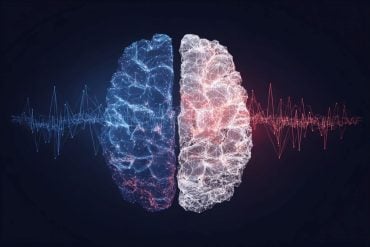Summary: Exposure to artificial light while sleeping is associated with weight gain and an increased risk of obesity in women. Compared to those who slept without artificial light, those who slept with television or light on were 17% more likely to have an 11 pound or more increase in weight.
Source: NIH/NIEHS
Sleeping with a television or light on in the room may be a risk factor for gaining weight or developing obesity, according to scientists at the National Institutes of Health. The research, which was published online June 10 in JAMA Internal Medicine, is the first to find an association between any exposure to artificial light at night while sleeping and weight gain in women. The results suggest that cutting off lights at bedtime could reduce women’s chances of becoming obese.
The research team used questionnaire data from 43,722 women in the Sister Study, a cohort study that examines risk factors for breast cancer and other diseases. The participants, aged 35-74 years, had no history of cancer or cardiovascular disease and were not shift workers, daytime sleepers, or pregnant when the study began. The study questionnaire asked whether the women slept with no light, a small nightlight, light outside of the room, or a light or television on in the room.
The scientists used weight, height, waist and hip circumference, and body mass index measurements taken at baseline, as well as self-reported information on weight at baseline and follow-up five years later. Using this information, the scientists were able to study obesity and weight gain in women exposed to artificial light at night with women who reported sleeping in dark rooms.
The results varied with the level of artificial light at night exposure. For example, using a small nightlight was not associated with weight gain, whereas women who slept with a light or television on were 17% more likely to have gained 5 kilograms, approximately 11 pounds, or more over the follow-up period. The association with having light coming from outside the room was more modest.
Also, the scientists wondered if not getting enough rest factored into the findings.

“Although poor sleep by itself was associated with obesity and weight gain, it did not explain the associations between exposure to artificial light while sleeping and weight,” said corresponding author Dale Sandler, Ph.D., chief of the Epidemiology Branch at the National Institute of Environmental Health Sciences (NIEHS), part of NIH.
Co-author Chandra Jackson, Ph.D., head of the NIEHS Social and Environmental Determinants of Health Equity Group, is interested in racial disparities in sleep health. She notes that for many who live in urban environments, light at night is more common and should be considered. Streetlights, store front neon signs, and other light sources can suppress the sleep hormone melatonin and the natural 24-hour light-dark cycle of circadian rhythms.
“Humans are genetically adapted to a natural environment consisting of sunlight during the day and darkness at night,” Jackson said.
“Exposure to artificial light at night may alter hormones and other biological processes in ways that raise the risk of health conditions like obesity.”
The authors acknowledge that other confounding factors could explain the associations between artificial light at night and weight gain. However, their findings did not change when analyses controlled for characteristics that may be associated with exposure to light at night. These factors included age, having an older spouse or children in the home, race, socioeconomic status, calories consumed, and physical activity. Also, the study did not include men.
Lead author Yong-Moon (Mark) Park, M.D., Ph.D., is a postdoctoral fellow in Sandler’s group. He said the research suggests a viable public health strategy to reduce obesity incidence in women.
“Unhealthy high-calorie diet and sedentary behaviors have been the most commonly cited factors to explain the continuing rise in obesity,” Park said. “This study highlights the importance of artificial light at night and gives women who sleep with lights or the television on a way to improve their health.”
Source:
NIH/NIEHS
Media Contacts:
Robin Arnette – NIH/NIEHS
Image Source:
The image is credited to NIEHS.
Original Research: Closed access
“Association of Exposure to Artificial Light at Night While Sleeping With Risk of Obesity in Womenn”. Yong-Moon Mark Park, MD, PhD; Alexandra J. White, PhD; Chandra L. Jackson, PhD, MS; Clarice R. Weinberg, PhD; Dale P. Sandler, PhD.
JAMA Internal Medicine. doi:10.1001/jamainternmed.2019.0571
Abstract
Association of Exposure to Artificial Light at Night While Sleeping With Risk of Obesity in Women
Importance Short sleep has been associated with obesity, but to date the association between exposure to artificial light at night (ALAN) while sleeping and obesity is unknown.
Objective To determine whether ALAN exposure while sleeping is associated with the prevalence and risk of obesity.
Design, Setting, and Participants This baseline and prospective analysis included women aged 35 to 74 years enrolled in the Sister Study in all 50 US states and Puerto Rico from July 2003 through March 2009. Follow-up was completed on August 14, 2015. A total of 43 722 women with no history of cancer or cardiovascular disease who were not shift workers, daytime sleepers, or pregnant at baseline were included in the analysis. Data were analyzed from September 1, 2017, through December 31, 2018.
Exposures Artificial light at night while sleeping reported at enrollment, categorized as no light, small nightlight in the room, light outside the room, and light or television in the room.
Main Outcomes and Measures Prevalent obesity at baseline was based on measured general obesity (body mass index [BMI] ≥30.0) and central obesity (waist circumference [WC] ≥88 cm, waist-to-hip ratio [WHR] ≥0.85, or waist-to-height ratio [WHtR]≥0.5). To evaluate incident overweight and obesity, self-reported BMI at enrollment was compared with self-reported BMI at follow-up (mean [SD] follow-up, 5.7 [1.0] years). Generalized log-linear models with robust error variance were used to estimate multivariable-adjusted prevalence ratios (PRs) and relative risks (RRs) with 95% CIs for prevalent and incident obesity.
Results Among the population of 43 722 women (mean [SD] age, 55.4 [8.9] years), having any ALAN exposure while sleeping was positively associated with a higher prevalence of obesity at baseline, as measured using BMI (PR, 1.03; 95% CI, 1.02-1.03), WC (PR, 1.12; 95% CI, 1.09-1.16), WHR (PR, 1.04; 95% CI, 1.00-1.08), and WHtR (PR, 1.07; 95% CI, 1.04-1.09), after adjusting for confounding factors, with P < .001 for trend for each measure. Having any ALAN exposure while sleeping was also associated with incident obesity (RR, 1.19; 95% CI, 1.06-1.34). Compared with no ALAN, sleeping with a television or a light on in the room was associated with gaining 5 kg or more (RR, 1.17; 95% CI, 1.08-1.27; P < .001 for trend), a BMI increase of 10% or more (RR, 1.13; 95% CI, 1.02-1.26; P = .04 for trend), incident overweight (RR, 1.22; 95% CI,1.06-1.40; P = .03 for trend), and incident obesity (RR, 1.33; 95% CI, 1.13-1.57; P < .001 for trend). Results were supported by sensitivity analyses and additional multivariable analyses including potential mediators such as sleep duration and quality, diet, and physical activity.
Conclusions and Relevance These results suggest that exposure to ALAN while sleeping may be a risk factor for weight gain and development of overweight or obesity. Further prospective and interventional studies could help elucidate this association and clarify whether lowering exposure to ALAN while sleeping can promote obesity prevention.







